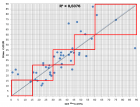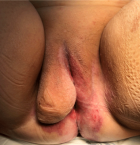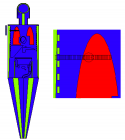Table of Contents
Anti-anxiety effects in mice following acute administration of Ficus Thonningii (wild fig)
Published on: 11th September, 2018
OCLC Number/Unique Identifier: 7856121803
The effect of acute administration of ethanol extract of F. thoningii on anxiety and fear in Swiss white mice was studied. 30 adult Swiss white mice of both sexes were randomly divided in to three groups of 10 mice each. Group1 served as the control and was administered normal saline only. Group 2 (low dose group) was administered 10mg/kg ethanol extract of the F. thoningii, while group 3 (high dose group) was given 20mg/kg of the same extract. All animals were allowed food and water ad libitum. Neurobehavioral parameter was assessed using the light/dark transition box. The analysis of variance (ANOVA) was used to test for variability within and among groups. Results were expressed as Mean ±SEM (standard error of the mean) and probability level p<0.05 was accepted as significant. The result showed that the frequency of transition in the light/dark transition box was significantly increased in the test groups (p<0.05; p<0.01).Similarly, the Light Box Duration was also significantly increased (p<0.01) in the low and high dose groups respectively. However, the Dark box duration was significantly decreased (p<0.05; p<0.01) in the low and high dose groups compared to control. This index showed a decreased level of anxiety and fear in the test groups. This was followed by a corresponding trend of decreased frequency of stretch attend posture and duration of freezing in the light/dark transition box (p<0.01; p<0.001) compared to the control. Summarily, acute administration of ethanol extract of F. thonningii causes calmness and sedation in moderate and high doses. It is therefore likely that it reduces aggression. If the result from this finding is extrapolated to humans, F. thoningii could be used to reduce anxiety disorders.
Mindset kinetics and some depression status: A new quantitative model under biochemical - toxicology approach?
Published on: 24th July, 2018
Depression: According Pubmed Health: Depression is a state of low mood and aversion to activity that can affect a person’s thoughts, behavior, feelings and sense of well-being (moderate or severe).
Can we consider some depression status due to high amount of some stressant stimulus? Or continuous stress in a limited (or long) period? How can react mindset and brain in management an high amount of negative stressing thinking? Observing some relevant literature also mindset kinetics must be considered to better classify this kind of disorder under a specific endogenous –exogenous biochemical-toxicological aspect.
Concept like Kinetics, reaction velocity limits, saturation of the systems, residual buffer properties are currently used in biochemistry and related discipline.
This concepts can be applied also in some depression condition to better explain some phenomena?
Responding to Disasters: More than economic and infrastructure interventions
Published on: 24th April, 2018
OCLC Number/Unique Identifier: 1051150494
Objectives: Natural disasters confront individuals, communities and governments with the challenge of rebuilding and addressing psychosocial sequelae. With the increasing number of natural disasters it is timely to evaluate the efficacy of interventions and strategies to address the mental health needs of individuals and the community.
Method: An evaluation of literature related to the psychological impact of natural disasters, treatment efficacy and government strategies to confront the social and psychological impact of natural disasters for the period 1983-2016 was undertaken.
Results: Epidemiological studies following natural disasters despite the use of differing psychological measures demonstrate significant psychological morbidity - anxiety (7-42%), complicated grief (28-41%), depression (6.5-38%), post-traumatic stress disorder (11-89%) and substance misuse (1.3-24%). Intervention studies post-disaster demonstrate efficacy variability.
Conclusions: The increase in the number and impact of meteorological and hydrological events since the 1980s and the psychological, social and economic consequences of these events has resulted in the development and implementation of government policies to confront the immediate and long-term adverse outcomes. The focus is typically on resources and infrastructure redevelopment with less focus on social and mental health interventions with long-term evaluation of interventions uncommon. The consequence of natural disasters emphasizes the importance developing strategies to ensure effective evaluated psychosocial interventions are available across at-risk communities.
Vestibular-limbic relationships: Brain mapping
Published on: 16th March, 2018
OCLC Number/Unique Identifier: 7666356622
Vestibular disorders and anxiety are closely related, probably because they share some neuronal pathways. Ageing and patient comorbidities are important facilitating factors, and multiple vascular risk factors could contribute to the onset of a vestibular syndrome called vascular vertigo. White matter lesions (WML) are often seen on magnetic resonance imaging (MRI) scans of elderly people and are related to various geriatric disorders, including dizziness. The cause of this correlation could be the disruption of neuronal networks that mediate higher vestibular cortical function. Numerous neuronal pathways link the vestibular network with limbic structures and the prefrontal cortex modulates anxiety through its connections to amygdala. The aim of the present work was to investigate the correlation between WML, amygdala and cognitive functions.
May we feed cancer?
Published on: 12th February, 2018
The patient with an oncological disease presents a series of discomforts related to the psychological sphere such as depression, pain, sense of usefulness, anger, but also inconveniences related to food sphere. Neoplastic disease interferes with eating behaviour for several reasons. The communication of the diagnosis can create a state of anorexia as a result of the shock; certain tumours of the gastrointestinal tract-gold (mouth, esophagus, stomach, colon and rectum, but also pancreas and liver) are directly responsible for the possible alteration of food intake; alteration in eating behaviour may be secondary to the main therapeutic treatments. The link between food and cancer is not only evident in case of disease, but also in case of prevention, in fact a growing number of studies indicates more an more clearly the close correlation between a healthy diet and prevention of oncological diseases although at present time it is not still possible to give definitive results. The diagnosis of a person is like a melody in which some notes are repeated but their combination is almost infinite, because each person has different eating needs, as well as different psychological needs, and the starting point for a good professional must necessarily be a ‘customized’ diagnosis. This ‘diagnosis of well-being’, tailor-made for each person, involves professionals in both the food and psychological and behavioural sectors, since the individual needs have to be evaluated globally.
Finally, the professionals of human behaviour in food consumption, and the chemical and science processing experts, have the duty not to limit themselves to a single refusal against the use of certain foods, but framing the phenomenon in a wider perspective and, as experts of human health, to propose alternatives.

If you are already a member of our network and need to keep track of any developments regarding a question you have already submitted, click "take me to my Query."


















































































































































